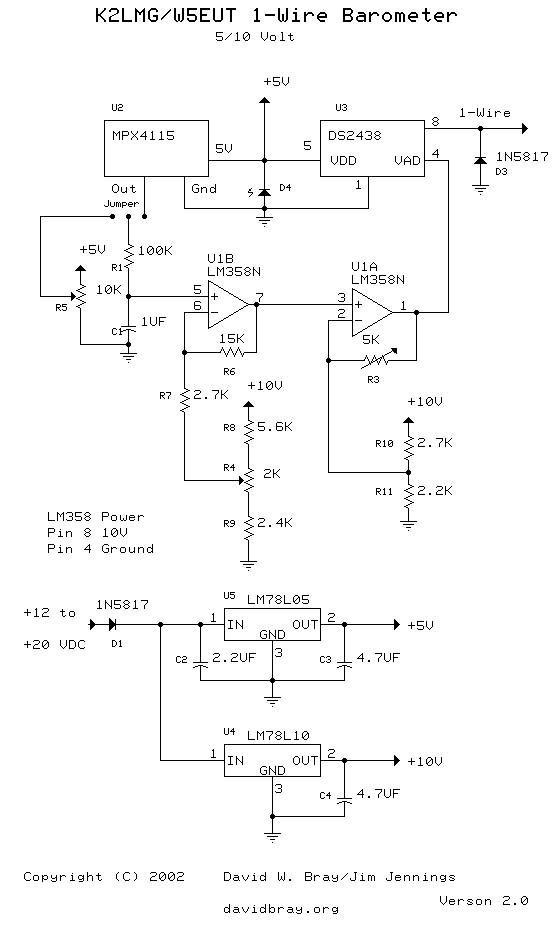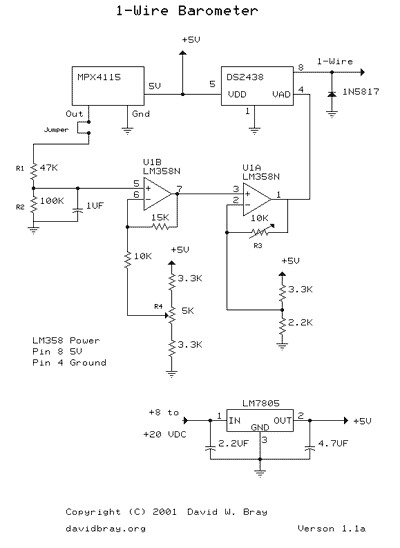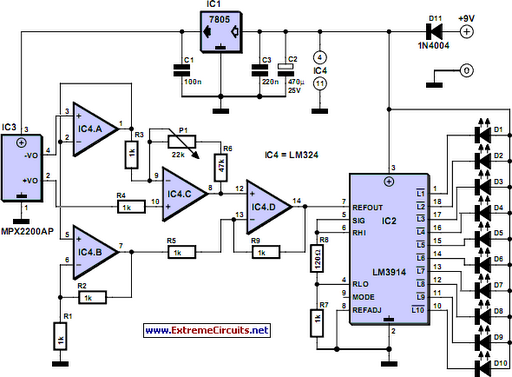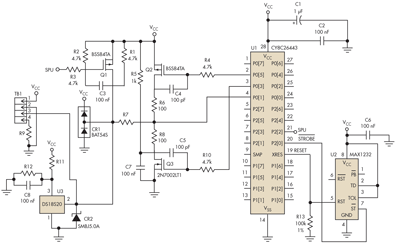
1-Wire Barometer Calibration
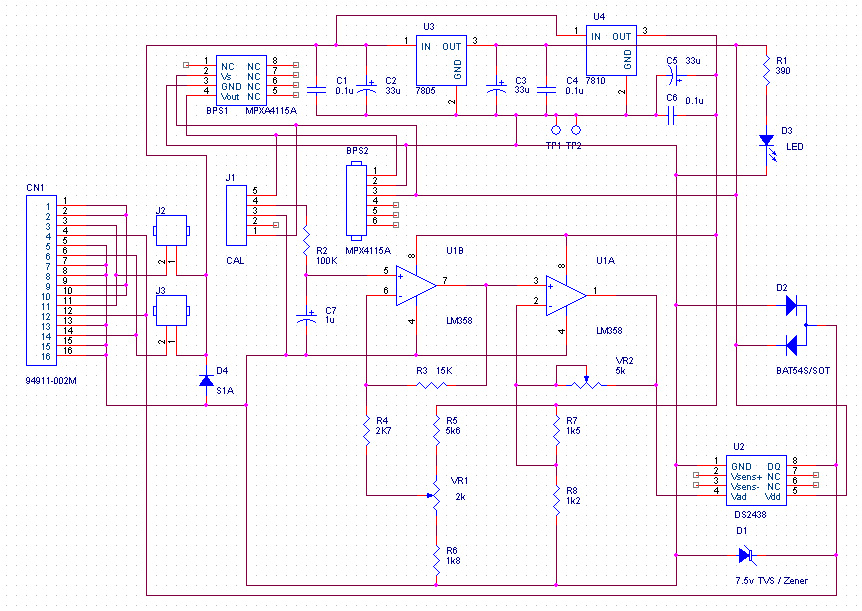
The resolution of the barometric pressure is approximately 0.00417 inHg (0.0139 kPa) within a pressure range of 31.0 to 28.0 inHg (105.0 to 95.0 kPa, or 1050 to 950 mb or hPa). Higher resolutions can be achieved with a narrower pressure range. The circuit necessitates an additional power source apart from the 1-Wire network, as the MPX4115 requires about 7 mA of current. This demand exceeds what a 1-Wire network can supply without a complex circuit designed to store parasitic power for brief current bursts during pressure measurements. For barometric pressures, the MPX4115 output voltage varies from around 4.25 to 3.79 volts at sea level, and approximately 2.77 to 2.45 volts at an altitude of 10,000 feet. Most of this output range exceeds the active voltage range of a 5-volt operational amplifier (op-amp) circuit. Consequently, the sensor voltage is referenced to the power supply instead of ground, which is the desired configuration. Fortunately, the DS2438 Smart Battery Monitor can accept inputs as high as 10 volts. Thus, by supplying the op-amp with 10 volts, the MPX4115 output remains within the operational range of both the op-amp and the DS2438. The output from the MPX4115 is routed through an RC filter to the op-amp stage, U1B, which has a fixed gain of approximately 4. This stage features an adjustable voltage input that is combined with the barometric sensor output within the op-amp, facilitating the adjustment of the output voltage offset for the A/D converter. Two 10-turn potentiometers (pots) are utilized to control gain and offset; VR2 adjusts the gain of U1A, while VR1 modifies the output voltage offset to the 1-Wire DS2438 A/D converter. It is important to note that the MPX4115 feeds R2 through a jumper on J1, allowing for easy voltage input changes from sources other than the MPX4115, such as a calibration tool. The schematic presented is not the only viable configuration; resistor values can be altered for different barometric pressure ranges and resolutions. Excel spreadsheets provided by Dave Bray assist with design modifications for various barometric pressure ranges and pre-calibration of the two pots. Version 3.0 includes a comprehensive schematic with detailed parts list, simulator, and calibration instructions to aid in construction, modifications, and calibration. After constructing the barometer and completing the initial calibration, it is advisable to conduct a final calibration after several days of operation. Achieving accurate barometer calibration will require adjustments over multiple cycles of barometric pressure changes. The initial calibration may not be precise unless the MPX4115 exhibits the same output versus pressure slope as the typical sensor. It is recommended to create a spreadsheet documenting local airport pressure against readings, collecting a substantial number of readings across a range of pressures. A sample 14-day data spreadsheet with a pressure range of 1.27 inHg to 30.58 inHg is provided, with the barometer calibrated for a range of 28.8 to 30.8 inHg, yielding a resolution of 0.01 inHg. (This data was sourced from the David Bray Barometer V1.1a.) Once results are compiled, a linear trendline (regression) can be used to determine the slope of local readings compared to airport data. If the trendline slope deviates from 1.0, it can be employed to adjust the gain resistor VR2. For instance, if the current VR2 resistance is 3K and the slope is 1.05, the new VR2 resistance should be adjusted to 3K/1.05 = 2.85K. Prior to investing significant time in achieving precise calibration, it is essential to define the desired range of pressure changes to monitor and the acceptable output voltage range from U1A. Data collection for the spreadsheet can be performed by varying the input at J1 pin 4 in small increments and recording the voltages at both J1 pin 4 and LM358 pin 7, followed by plotting the results on the spreadsheet.
The circuit described utilizes the MPX4115 barometric pressure sensor, which is a piezoresistive transducer that generates a voltage output proportional to the applied pressure. The sensor operates effectively within the specified pressure range, providing a resolution that is suitable for various applications, including weather monitoring and altitude measurement.
The integration with the DS2438 Smart Battery Monitor allows for a seamless interface with the 1-Wire network, enabling data logging and monitoring of the pressure readings. The op-amp stage is critical for amplifying the sensor's output, ensuring that the signal levels are compatible with the A/D converter. The use of potentiometers for gain and offset adjustments provides flexibility in calibration, allowing for fine-tuning based on specific environmental conditions and sensor characteristics.
The RC filter preceding the op-amp stage serves to smooth out any noise in the signal, enhancing the accuracy of the readings. The design's modularity, with the ability to change resistor values and input sources, allows for customization based on the specific requirements of the application. The mention of calibration procedures highlights the importance of ensuring measurement accuracy, particularly in dynamic environments where pressure changes frequently occur.
Overall, this circuit design presents a robust solution for accurately measuring barometric pressure, with detailed attention to calibration and adaptability for different operational scenarios. The comprehensive approach to design and calibration ensures that users can achieve reliable and precise barometric measurements over time.The resolution of the barometric pressure is about 0. 00417 inHg (0. 0139 kPa) for a pressure range of 31. 0 to 28. 0 inHg (105. 0 to 95. 0 kPa, or 1050 to 950 mb or hPa). Better resolutions are possible with a more restricted pressure range. The circuit requires an additional power source other than that of the 1-Wire network. The MPX4115 requires abou t 7 ma of current. This is more than a 1-Wire network can provide without an elaborate circuit to store parasitic power from the 1-Wire network for short burst of current for pressure measurements. For barometric pressures the MPX4115 output voltage ranges from about 4. 25 to 3. 79 volts at sea level, and about 2. 77 to 2. 45 volts at 10, 000 feet. Most of this range is above the active voltage range of a 5 volt opamp circuit. In effect the sensor voltage is referenced to the power supply, not ground as desired. Fortunately the DS2438 Smart Battery Monitor accepts inputs as high as 10 volts. Thus by powering an opamp from 10 volts the output of the MPX4115 is well in the opamp and DS2438 range.
The MPX4115 output is fed through a RC filter to opamp stage, U1B, which has a fixed gain of approximately 4. This stage has an adjustable voltage input which is added to the barometric sensor output within the opamp, thereby allowing the adjustment of the output voltage offset to the A/D converter.
The two 10-turn potentiometers (pots) control the gain and offset. VR2 controls the gain of U1A and VR1 controls the offset of the output voltage to the 1-Wire DS2438 A/D converter. Note that the MPX4115 feeds R2 through a jumper on J1. This allows easy change of the input voltage from a source other than the MPX4115 like the calibration tool.
The design presented in the schematic above is not the only possible barometer configuration the values of the resistors can be modified for different ranges of barometric pressure and resolutions. Dave Bray has provided Excel Spreadsheets for modifying the design for different barometric pressure ranges and resolutions, and for pre-calibration of the two pots.
Version 3. 0. Large schematic with full details, parts list, version 3. 0 simulator, and calibration details. Needed to help construction, for option modifications, and calibration. Once you have constructed your barometer and done the initial calibration, it is recommended that you do a final calibration after the barometer has been operated for several days. Getting your barometer accuracy calibrated will take adjustment over several cycles of barometric pressure change.
The initial calibration will not be accurate unless your MPX4115 has the same output vs pressure slope as the typical sensor. Our recommendation is that you do not attempt to adjust the potentiometers of your barometer until you create a spreadsheet of local airport pressure vs your readings, and do this for a significant number of readings over a range of pressures.
Following is a 14 day data spreadsheet with a pressure range of 1. 27 inHg - 29. 31 to 30. 58. The barometer was calibrated for a range of 28. 8 to 30. 8, giving a resolution of 0. 01 inHg. (This data was obtained from the David Bray Barometer V1. 1a. ) Once you have those results you can use a linear trendline (regression) to find the slope of local vs airport readings. If the trendline slope is not 1. 0, use that slope to correct your gain resistor VR2. The slope will be a multiplicitive change to the current VR2 resistance. For example: if current VR2 resistance is 3K and the slope is 1. 05, change VR2 to 3K/1. 05 = 2. 85K. Before you spend too much time getting an accurate calibration you should decide what range of pressure changes you want to track and what range of output voltages of U1A you consider satisfactory.
3. Collect data for a spreadsheet by changing J1 pin 4 input in small steps recording the voltages at J1 pin 4 and LM358 pin 7. Plot it on the spread sheet. Following is a sample graph 🔗 External reference
The circuit described utilizes the MPX4115 barometric pressure sensor, which is a piezoresistive transducer that generates a voltage output proportional to the applied pressure. The sensor operates effectively within the specified pressure range, providing a resolution that is suitable for various applications, including weather monitoring and altitude measurement.
The integration with the DS2438 Smart Battery Monitor allows for a seamless interface with the 1-Wire network, enabling data logging and monitoring of the pressure readings. The op-amp stage is critical for amplifying the sensor's output, ensuring that the signal levels are compatible with the A/D converter. The use of potentiometers for gain and offset adjustments provides flexibility in calibration, allowing for fine-tuning based on specific environmental conditions and sensor characteristics.
The RC filter preceding the op-amp stage serves to smooth out any noise in the signal, enhancing the accuracy of the readings. The design's modularity, with the ability to change resistor values and input sources, allows for customization based on the specific requirements of the application. The mention of calibration procedures highlights the importance of ensuring measurement accuracy, particularly in dynamic environments where pressure changes frequently occur.
Overall, this circuit design presents a robust solution for accurately measuring barometric pressure, with detailed attention to calibration and adaptability for different operational scenarios. The comprehensive approach to design and calibration ensures that users can achieve reliable and precise barometric measurements over time.The resolution of the barometric pressure is about 0. 00417 inHg (0. 0139 kPa) for a pressure range of 31. 0 to 28. 0 inHg (105. 0 to 95. 0 kPa, or 1050 to 950 mb or hPa). Better resolutions are possible with a more restricted pressure range. The circuit requires an additional power source other than that of the 1-Wire network. The MPX4115 requires abou t 7 ma of current. This is more than a 1-Wire network can provide without an elaborate circuit to store parasitic power from the 1-Wire network for short burst of current for pressure measurements. For barometric pressures the MPX4115 output voltage ranges from about 4. 25 to 3. 79 volts at sea level, and about 2. 77 to 2. 45 volts at 10, 000 feet. Most of this range is above the active voltage range of a 5 volt opamp circuit. In effect the sensor voltage is referenced to the power supply, not ground as desired. Fortunately the DS2438 Smart Battery Monitor accepts inputs as high as 10 volts. Thus by powering an opamp from 10 volts the output of the MPX4115 is well in the opamp and DS2438 range.
The MPX4115 output is fed through a RC filter to opamp stage, U1B, which has a fixed gain of approximately 4. This stage has an adjustable voltage input which is added to the barometric sensor output within the opamp, thereby allowing the adjustment of the output voltage offset to the A/D converter.
The two 10-turn potentiometers (pots) control the gain and offset. VR2 controls the gain of U1A and VR1 controls the offset of the output voltage to the 1-Wire DS2438 A/D converter. Note that the MPX4115 feeds R2 through a jumper on J1. This allows easy change of the input voltage from a source other than the MPX4115 like the calibration tool.
The design presented in the schematic above is not the only possible barometer configuration the values of the resistors can be modified for different ranges of barometric pressure and resolutions. Dave Bray has provided Excel Spreadsheets for modifying the design for different barometric pressure ranges and resolutions, and for pre-calibration of the two pots.
Version 3. 0. Large schematic with full details, parts list, version 3. 0 simulator, and calibration details. Needed to help construction, for option modifications, and calibration. Once you have constructed your barometer and done the initial calibration, it is recommended that you do a final calibration after the barometer has been operated for several days. Getting your barometer accuracy calibrated will take adjustment over several cycles of barometric pressure change.
The initial calibration will not be accurate unless your MPX4115 has the same output vs pressure slope as the typical sensor. Our recommendation is that you do not attempt to adjust the potentiometers of your barometer until you create a spreadsheet of local airport pressure vs your readings, and do this for a significant number of readings over a range of pressures.
Following is a 14 day data spreadsheet with a pressure range of 1. 27 inHg - 29. 31 to 30. 58. The barometer was calibrated for a range of 28. 8 to 30. 8, giving a resolution of 0. 01 inHg. (This data was obtained from the David Bray Barometer V1. 1a. ) Once you have those results you can use a linear trendline (regression) to find the slope of local vs airport readings. If the trendline slope is not 1. 0, use that slope to correct your gain resistor VR2. The slope will be a multiplicitive change to the current VR2 resistance. For example: if current VR2 resistance is 3K and the slope is 1. 05, change VR2 to 3K/1. 05 = 2. 85K. Before you spend too much time getting an accurate calibration you should decide what range of pressure changes you want to track and what range of output voltages of U1A you consider satisfactory.
3. Collect data for a spreadsheet by changing J1 pin 4 input in small steps recording the voltages at J1 pin 4 and LM358 pin 7. Plot it on the spread sheet. Following is a sample graph 🔗 External reference
